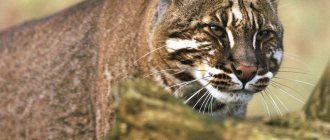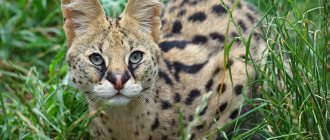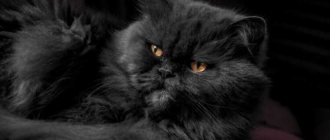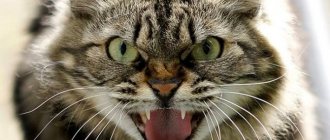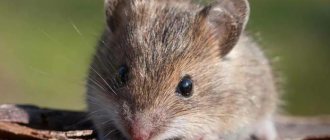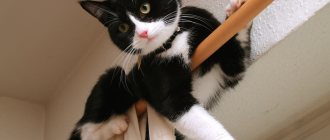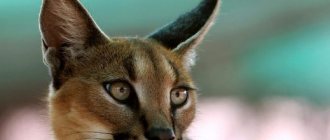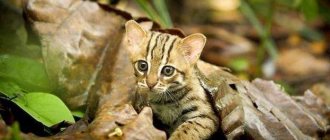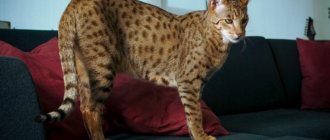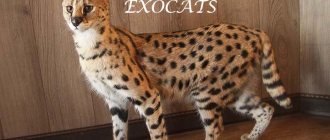Temminck's cat is rightfully one of the little-studied and rare animals of our planet. This is not an artificially bred breed or one formed as a result of natural selection, but a wild variety.
The population of this animal in natural conditions is small, and not all, even very well-known, zoos can boast that they have this rare and beautiful animal, with which many amazing legends of Asian peoples are associated.
Description
The Temminck cat has a moderate size, the body length including the head is from 116 to 161 cm. The height at the withers is about 56 cm. Their tail is 1/2-1/3 of the total size. Typically, adults weigh 12-15 kg, which is about two or three times the weight of a domestic cat. Coat colors include the following colors: golden brown, brown, black, red, red and grey. Their coat is of moderate length. The underbelly, the inside of the legs and the lower part of the tail are white. The cat has a well-developed muscular system. Long paws combined with a long tail allow the Temminck cat to climb trees well, although, as a rule, this species lives on the ground. Females are smaller than males.
Appearance
- Life expectancy: no more than 20 years (in captivity).
- Color: the main body shade is dark brown, brown, but there are also subspecies of gray or black colors. At the bottom and at the tip of the tail there are areas of predominantly white tones, and there are characteristic white stripes near the eyes. Some subspecies have distinctive spots on their fur.
- Coat: dense, long, fits well to the body.
- Height at withers: 70-105 cm (depending on habitat).
- Weight: from 12 to 16 kg.
- Litter: 1-3 kittens.
- Recognized by: IUCN.
Did you know? The Asian wild cat is still widely used in Eastern folk medicine, as the tissues of this animal are believed to be endowed with healing substances. In addition, the meat of this mammal species is one of the most expensive delicacies in the world.
- The appearance of this animal is typical for all representatives of large cat breeds, so this cat is often even confused with a puma, since it is very similar to this animal, but differs in its smaller size. Her body is powerful, muscular and flexible, which gives the cat a huge advantage in speed and agility relative to prey.
- Head : small in size, round in shape, elongated muzzle.
- Ears : Set high above the head, tips rounded.
- Eyes : predominantly yellowish or yellow-brown, pupils vertical.
- Legs : paws are high, the front ones are shorter than the hind ones, the claws on the paws are retractable.
- Tail : large, its length reaches 40-55 cm.
Area
Temminck cats are found in the Eastern region and parts of the Palaearctic, southwest Asia, ranging from China and India, through the Malay Peninsula, Thailand and Vietnam. Although the presence of vegetation and adaptation to different environments should make this species thriving, their range is decreasing with increased human activity and high levels of poaching. Currently, these cats can be found in the Phu khieo Wildlife Sanctuary and the Jerangau Forest Reserve.
Habitat
Asian golden cats primarily live in forests, ranging from tropical/subtropical evergreen forests, mixed forests, and dry deciduous forests. They live at altitudes from 1100 to 3738 m (average altitude 2517 m). Phu khieo Wildlife Sanctuary, in Thailand, is considered an ideal habitat for this species. It consists of an enclosed forest, a meadow and an abandoned garden. Using a radio collar, in the Phu khieo nature reserve, Temminck cats were recorded at an altitude of 3738 m (the highest altitude where this species was found). Although habitats are variable within the reserve, Asian golden cats do not show a preference for any particular habitat.
Links[edit]
- ^ abcd McCarthy, J.; Dahal, S.; Dhendup, T.; Grey, TNE; Mukherjee, S.; Rahman, H.; Riordan, P.; Buntua, N., and Wilcox, D. (2015). "Catopuma temminckii" IUCN Red List of Threatened Species
.
2015
: e.T4038A97165437. - ^ abcde Sunquist, M. & Sunquist, F. (2002). "The Asian golden cat Catopuma temminckii (Vigors and Horsfield, 1827)". Wild cats of the world
. Chicago: University of Chicago Press. pp. 52–56. ISBN 0-226-77999-8. - ^ ab Vigors, N. A. & Horsfield, T. (1827). "Description of two species of the genus Felis in the collections of the Zoological Society". Zoological Journal
.
III
(11):449–451. - ^ ab Hodgson, B. C. (1831). "Some information about a new species of Felis". Collections in Science
.
III
(30): 177–178. - ^ ab Milne-Edwards, A. (1872). » Felis tristis, nov. Sp." . Étude pour servir à l'histoire de la faune mammalogique de la Chine. Recherches pour servir à l'histoire des mammifères comprenant des considérations sur la classification de ces animaux
. Paris: J. Masson. pp. 223-224. - Severtzow, M. N. (1858). "Notice on the multifaceted classification of carnivores, special animals, and research into the general zoology of carnivores". Revue et Magasin de Zoologie Pure et Appliquée
.
X
: 385–396. - Kitchener, A.C.; Breitenmoser-Würsten, C.; Eizirik, E.; Gentry, A.; Werdelin, L.; Wilting, A.; Yamaguchi, N.; Abramov, A.V.; Christiansen, P.; Driscoll, C.; Duckworth, J. W.; Johnson, W.; Luo, S.-J.; Meijaard, E.; O'Donoghue, P.; Sanderson, J.; Seymour, K.; Bruford, M.; Groves, C.; Hoffmann, M.; Nowell, K.; Timmons, Z., & Tobe, S. (2017). "Revised Taxonomy of Felids: Final Report of the IUCN Felid Specialist Group Task Force on Cat Classification" (PDF). Cat news
. Special Issue 11: 36-37. - ^ a b c d Johnson, WE; Eizirik, E.; Pecon-Slattery, J.; Murphy, W.J.; Antunes, A.; Teeling, E. & O'Brien, S. J. (2006). "Late Miocene radiation of modern felids: a genetic assessment". The science
.
311
(5757):73–77. Bibcode: 2006Sci…311…73J. DOI: 10.1126/science.1122277. PMID 16400146. S2CID 41672825. - ^ abc Werdelin, L.; Yamaguchi, N.; Johnson, W.E. & O'Brien, S. J. (2010). "Phylogeny and evolution of cats (Felidae)". In Macdonald, D. W. & Loveridge, A. J. (eds.). Biology and Conservation of Wild Felids
. Oxford, UK: Oxford University Press. pp. 59–82. ISBN 978-0-19-923445-5. - ^ abcd Li, G.; Davis, B. W.; Eizirik, E., & Murphy, W. J. (2016). "Phylogenomic evidence for ancient hybridization in the genomes of living cats (Felidae)". Genomic Research
.
26
(1): 1–11. DOI: 10.1101/gr.186668.114. PMC 4691742. PMID 26518481. - Jump up
↑ Pocock, R.I. (1939).
"Genus Profelis Severtzow". Fauna of British India, including Ceylon and Burma. Mammals. — Volume 1
. London: Taylor and Francis, Ltd., pp. 258–266. - ^ a b c Bashir, T.; Bhattacharya, T.; Poudyal, K. and Satyakumar, S. (2011). "Known sightings of the melanistic Asian golden cat ( Pardofelis temminckii
) from Sikkim, India."
NEBIO
.
2
(1): 2–4. - ^ab Jigme, K. (2011). "Four color changes and altitude recording of the Asian golden cat in Bhutan." Cat News
(55): 12–13. - ^ ab Nadig, S.; R., N.; Silva, A. P. (2016). "Small Cats in the Himalayan Foothills: The Asian Golden Cat from Nonghillem Wildlife Sanctuary, India" (PDF). Small Wild Cat Conservation News
.
2
: 23. Archived from the original (PDF) on 10/06/2016. Retrieved January 1, 2021. - Mukherjee, S.; Choudhary, P.; Arthreya, R. and Karunakaran, P.V. (2018). "The Tale of Tails - an attempt to decipher the distribution of small cats by tail length". In Appel, A.; Mukherjee, S. and Chain, S.M. (ed.). Proceedings of the First International Small Wild Cat Conservation Summit, 11–14 September 2021, UK
. Bad Marienberg, Germany; Coimbatore, India; Oxford, UK: Wildcat Network; Salim Ali Center for Ornithology and Natural History; Borneo Nature Trust. pp. 11–12. - ^ abc Ghose, M.; Sharma, D. and Murali, N.S. (2019). "First photographic evidence of the polymorphic Asian golden cat Catopuma temminckii Vigors & Horsfield, 1827 (Mammalia: Carnivora: Felidae) in the Buxa Tiger Reserve, West Bengal, India". Journal of Taxa Threats
.
11
(4):13502–13505. DOI: 10.11609/jott.4254.11.4.13502-13505. - ^ abc Holden, J. (2001). "Small cats in Kerinci Seblat National Park, Sumatra, Indonesia." Cat News
(35): 11–14. - Haidir, I.A.; Dinata, Y.; Linkey, M. and McDonald, D.W. (2013). "Habitat area of the Asian golden cat and Sunda clouded leopard in the Kerinci Seblat landscape, west-central Sumatra." Cat News
(59): 7–10. - ^ ab Ghimiray, Y. & Pal, P. (2009). "First camera trap image of an Asian golden cat in Nepal" (PDF). Cat News
(51): 17. Archived from the original (PDF) on July 26, 2011. Retrieved July 10, 2021. - Jutzeler, E.; Xie, Y., & Vogt, C. (2010). "Asian golden cat in China." Cat News
(Special Issue 5): 40–41. - ^ a b c Wang, S. W. (2007). "A rare species of Asian golden cat in Jigme Singye Wangchuck National Park in Bhutan." Cat News
(47): 27–28. - ^ abcd Nowell, K.; Jackson, P. (1996). "Asian golden cat, Catopuma temmincki
(Vigors and Horsfield, 1827)."
Feral Cats: Status Review and Conservation Plan
. Gland, Switzerland: IUCN/SSC Cat Specialist Group. pp. 69−70. - Ellerman, Jr.; Morrison-Scott, T. C. S. (1966). » Felis temmincki Vigors & Horsfield, 1827″ . Checklist of mammals of the Palaearctic and India from 1758 to 1946
(second ed.). London: British Museum. pp. 311−312. - Koju, NP; Bashyal, B.; Pandey, B.P.; Thami, S.; Dhamala, M.K. and Shah, S.N. (2020). "New record of the Asian golden cat Catopuma temminckii Vigors & Horsfield, 1827 (Mammals: Carnivora: Felidae): photographic evidence of its western distribution in Gaurishankar Wildlife Sanctuary, Nepal". Journal of Taxa Threats
.
12
(2):15256–15261. DOI: 10.11609/jott.5227.12.2.15256-15261. - Chowdhury, A. (2007). "Encountering the Asian golden cat in the grasslands of Assam's Manas National Park." Cat News
(47): 29. - Gouda, J.; Sethi, J. & Chauhan, N. P. S. (2016). "First photograph of an Asian golden cat in Dampa Tiger Reserve, Mizoram, India." Cat News
(64): 26–27. - ^ ab Mukherjee, S.; Singh, P.; Silva, A.; Ri, C.; Kakati, K.; Borah, B.; Tapi, T.; Kadur, S.; Choudhary, P.; Srikanth, S.; Nadig, S.; Navya, R.; Björklund, R.; Ramakrishnan, U. (2019). "Patterns of activity of a guild of small and medium-sized felids (Mammalia: Carnivora: Felidae) in northeastern India". Journal of Taxa Threats
.
11
(4): 13432−13447. DOI: 10.11609/jott.4662.11.4.13432-13447. - Rao, M.; Than Myint; Than Zaw; Saw Htun (2005). "Hunting patterns in the rainforest adjacent to Hkakaborazi National Park, northern Myanmar". Oryx
.
39
(3):292–300. DOI: 10.1017/S0030605305000724. - Saw Sha Bwe Mu; Froese, G. Z. L.; Grey, T. N. E. (2017). "First structured camera trap surveys in Karen State, Myanmar, reveal high diversity of globally threatened mammals". Oryx
.
52
(3):537-543. DOI: 10.1017/S0030605316001113. - Duckworth, J. W.; Salter, R. E.; Hungbolin, K. (compilers) (1999). Wildlife in the Lao People's Democratic Republic: Status Report 1999 (PDF). Vientiane: IUCN - World Conservation Union, Wildlife Conservation Society, Center for Protected Areas and Watershed Management. Archived from the original (PDF) on 10/04/2011. Retrieved November 6, 2010.
- Johnson, A.; Vongkhamheng, C.; Saihongdam, T. (2009). "Diversity, status and conservation of small carnivores in a montane rainforest of northern Laos" (PDF). Oryx
.
43
(4):626–633. DOI: 10.1017/S0030605309990238. - Li, S.; Wang, D.; Lu, Z.; Mac Shea, W. J. (2010). "Cats Living with Pandas: Status of Wild Felids within the Range of Giant Pandas, China." Cat News
(52): 20–23. - Pusparini, W.; Wibisono, H. T.; Reddy, G.V.; Tarmizi; Bharata, P. (2014). "Small and medium-sized cats in Gunung Leuser National Park, Sumatra, Indonesia." Cat News
(Special Issue): 4–9. - Weiskopf, S. R.; McCarthy, J.L.; McCarthy, K.P.; Shiklomanov, AN; Wibisono, H. T.; Pusparini, V. (2019). "Conserving the value of forest fragments in Sumatra's increasingly agrarian landscape". Environmental protection
.
46
(4): 340–346. DOI: 10.1017/S0376892919000195. - Grassman Jr., LI; Tewes, M.E.; Sylvie, New Jersey; Kritiyuthanont, K. (2005). "Ecology of three sympatric felids in a mixed evergreen forest in North-Central Thailand" (PDF). Journal of Mammology
.
86
(1):29–38. DOI: 10.1644/1545-1542 (2005) 086 <0029: EOTSFI> 2.0.CO; 2. - ↑
Tong Yin (1967).
Wild animals of Burma.
Rangoon Gazette Ltd., Rangoon. - Biswas, B. & Ghose, R. K. (1982). Progress report 1 on a pilot study of a joint WWF-India/Zoological Survey of India project to review the status of small cats in eastern India.
Zoological Survey of India, Kolkata. - Jump up ↑
Jones, M. L. (1977).
Registration and life expectancy of felines in captivity.
In: Eaton, R. L. (ed.)
The World's Cats.
Vol. 3, no. 3. Seattle: Carnivore Research Institute, Burke Museum, University of Washington. - Jump up
↑ Mellen, J. (1989).
Reproductive behavior of small cats in captivity (Felis ssp.).
PhD. completed his dissertation at the University of California, Davis. - Prator, T., Thomas, W. D., Jones, M. and M. Dee (1988). A twenty-year review of selected rare raptors in captivity.
pp. 191–229.
In B. Dresser, R. Rees and E. Maruska, (eds.) Proceedings of the 5th World Conference on Captive Breeding of Endangered Species.
Cincinnati, Ohio. - Lynam, A. J.; Round, P.; Brockelman, Wyo. (2006). Status of Birds and Large Mammals of the Dong Payayen-Khao Yai Forest Complex, Thailand (PDF). Bangkok, Thailand: Biodiversity Research and Training Program and Wildlife Conservation Society. Archived from the original (PDF) on July 27, 2011. Retrieved November 6, 2010.
- Shepherd, CR; Nijman, W. (2008). Trade in wild cats in Myanmar (PDF). Petaling Jaya, Selangor, Malaysia: TRAFFIC Southeast Asia.
- EAZA Felid TAG (2009). EAZA Felid TAG Annual Report 2007-2008. Archived July 20, 2011, at the Wayback Machine. In: EAZA Yearbook 2007/2008. European Association of Zoos and Aquariums
- Lekagul, B.; McNeely, J. A. (1977). Mammals of Thailand
. Bangkok: Wildlife Conservation Association. - "เสือไฟกัดช้างตาย" . Bangkokbiznews
(in Thai). 2015. Retrieved August 1, 2021.
Reproduction
The breeding of Temminck cats remains relatively unknown, as they are difficult to spot in the wild. Wild individuals tend to be afraid of people and the process of mating of animals has not been observed. The Cincinnati, Heidelberg, Münster and Wassenaar zoos attempted to breed Asian golden cats, with a success rate of 78%. Zoos have carefully designed programs to successfully reproduce animals in captivity. Males become acquainted with females within 2 months, which allows the females to get to know the male well and avoid death.
Many zoos have experienced cat deaths during the breeding season. Males are kept in a separate area and may have visual, olfactory and auditory contact with females. In order to reduce aggressiveness, more food is added to each cell. After two months, the male and female are allowed for short periods of contact with each other. If no aggressive behavior occurs between them, the contact time gradually increases. Females and males stay together for 70 days, during which time they copulate. If the female has not given birth after 90 days, the male gets close to her again during estrus.
Estrus in females lasts 6 days, and the cycle repeats every 39 days. Pregnancy lasts 81 days. Females give birth to 1-3 young, which weigh on average 250 g at birth. In the wild, some females have been observed giving birth in hollow trees. The cubs are weaned at 6 months of age and reach independence at around 12 months, although this sometimes occurs as early as 9 months. Sexual maturity in females occurs at 19 months, and in males at 24 months. Temminck cats are difficult to spot in the wild. Zoos are trying to breed these animals in hopes of gaining more information regarding their behavior and reproduction.
Purchasing a Temminka kitten
This animal is now listed in the first CITES appendix, and smuggling is subject to a large fine and even imprisonment. Even large zoos find it difficult to acquire these rare and unique animals.
Only from single foreign breeders, with a long and persistent search, can you find “legitimate” kittens born from cats who themselves grew up in captivity and have all the necessary documents about their origin.
The cost of a kitten starts from 7-10 thousand dollars.
In order to seriously engage in breeding the Temminka Cat and its hybrid species in captivity, a person, first of all, needs to restore the natural population and stop the extinction of this rare animal.
For this purpose and to stop the deforestation of rare tropical forests, various associations have been created, including the World Conservation Organization, which includes a number of government and public companies.
1111
Nutrition
Temminck cats adapt to different foods. They consume ground squirrels, mounts, rodents, birds, reptiles and young hares. In the mountains of Sikkim, India, these cats hunt large animals such as wild pigs, Indian sambars and baby Asian buffalos. In areas where humans are present, they also prey on poultry, sheep and goats.
In captivity, the diet of Asian golden cats is not as varied as in the wild. They are fed meat that contains less than 10% fat because fattier foods can cause these cats to vomit. Calcium carbonate and multivitamins are also added to the food. The “dead, whole foods” provided to Temminck cats are chickens, rabbits, guinea pigs, rats and mice. In zoos, they receive 800-1500 g of food per day.
Is it possible to keep Temminka at home?
The Temminck cat is a wild animal, its temperament is not suitable for domestic living and it is practically impossible to tame and socialize due to its fearfulness and caution.
Currently, only a limited number of individuals are kept in zoos, nature reserves and specialized nurseries.
In Russia there are only two cats of different sexes in the Novosibirsk Zoo. It is noted that the individuals living in the enclosure allocated for them do not show any aggression towards the workers, but they are not interested in humans, do not strive for communication, they are calm and restrained in behavior.
Rare breeders note that even a kitten raised in captivity and weaned from its mother early as an adult should be kept only in a spacious enclosure, as it can be dangerous to humans.
With puberty, all the instincts of a predator awaken in a cat and, although the pet will never attack first, it is impossible to predict its behavior.
Perhaps over time, when several generations of these rare cats can be obtained in captivity, it will be possible to obtain hybrid varieties of Temminki that will be prone to socialization. After all, such experiences in the conditions of foreign breeding are not uncommon. These are the well-known Bengals (with the wild Bengal cat), Chausie (with the reed or swamp house cat), and Caraquets (with the caracal).
Behavior
Asian golden cats are territorial and solitary animals. Previous observations have shown that they are nocturnal, but a radio-collared field study on two individuals determined that peak activity occurs during the crepuscular and daytime hours. According to the study results, the average territory area of a male was 47.7 km², and that of a female was 32.6 km². Both sexes walked between 55 meters and 9 kilometers per day and were more active in July than in March.
Temminck cats can climb trees when necessary. They are capable of killing prey much larger than themselves. In captivity, Asian golden cats kill small prey by biting their necks, as is typical for felids.
Features of character and lifestyle
Photo: Golden cat Temminka
Little is known about the behavior of Temminck's cat. It was once thought to be primarily nocturnal, but recent evidence indicates that the cat may be more crepuscular or diurnal. Two radio-collared Temminck cats in Thailand's Phu Khieu National Park showed mostly diurnal and crepuscular activity peaks. Additionally, most of the Temminka cat photos were taken during the day in Kerinci Seblat and Bukit Barisan Selatan National Parks in Sumatra.
The range of two Temminck radar cats in Thailand in Phu Khieu National Park was 33 km² (female) and 48 km² (male) and overlapped significantly. In Sumatra, a radio-collared female spent much of her time outside the protected area in small patches of remnant forest located among coffee plantations.
Fun fact: Temminck cat vocalizations include hissing, spitting, meowing, purring, growling and gurgling. Other communication methods observed in Temminck cats in captivity include scent marking, urine spraying, raking trees and logs with their claws, and head rubbing against various objects, very similar to the behavior of a domestic cat.
Economic significance for humans
Positive
The meat of Temminck cats is considered a delicacy, and their bones are used for medicinal purposes. Their skin is sold, although this is considered illegal. According to local superstitions, setting fire to the skin of cats drives away tigers.
Negative
Asian golden cats are known to prey on domestic animals such as birds, sheep and goats.
History of the discovery of the golden Asian cat
Temminka received its name thanks to the efforts of the Dutch zoologist and naturalist Conrad Jacob Temminck, who was the first to describe it in 1827. Strictly speaking, the scientist had in mind a completely different animal and described the African golden cat, which is not even a relative of the Asian one. But the anatomy, appearance and living conditions turned out to be very similar. Such an evolutionary process, leading to the similarity of different systematic groups of animals, is called convergent evolution.
The Asian golden cat was first described in 1827
Temminck cat - Catopuma (Felis) temminckii, fire cat or, as it is also called, Asian golden cat belongs to the genus Catopum (subfamily of small cats) and is the closest relative of the Barneo (Kalemantan) cat.
